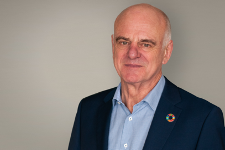
David Nabarro: Geneva’s finance and aid world must take risks and work together
To make food systems sustainable, the finance sector and the international organisations must take the plunge and cross over to the other side of the lake, said David Nabarro, senior adviser to the UN food summit, on the occasion of Building Bridges held in Geneva last week.
Bankers, CEOs, academics and heads of international organisations gathered last week for Geneva’s first sustainable finance summit, Building Bridges, in an effort to propose innovative solutions to the world’s biggest challenges. Despite sharing the same city, Geneva’s private and aid worlds rarely cross paths. Beyond occupying opposite sides of Lake Leman, their interests are rarely aligned.
For David Nabarro, senior adviser to the UN-led Food Systems Summit held in September 2021, food systems are a key area that could benefit from cooperation from such opposing sectors.
From production to transportation to consumption, food and agricultural activities are one of the main contributors to the rise in global temperatures. Yet they’re failing to feed the world’s population, with two billion people not having access to healthy diets, and an extra billion on the verge of hunger if they were to lose a third of their income, according to the Food and Agriculture Organization.
“You need dedicated solutions for the smallholder farmers and for the small and medium enterprises. If you get those in place, investing in systems offers really promising economic opportunities,” Nabarro told Geneva Solutions.
Currently the World Health Organization’s special envoy for Covid-19, Nabarro worked within the UN system for over 20 years at the crossroads between health, food, nutrition, sustainable development and climate change.
He participated in Building Bridges last week in a panel on innovative financial approaches for sustainable food systems. Ahead of the event on Tuesday, the health expert spoke to Sustainable Finance Geneva about the need for the finance and development sectors to come up with novel ways of partnering, even at the risk of facing scrutiny.
Food systems are a key driver of climate change and as population grows, demand will only keep rising. What role can sustainable finance play in making them more sustainable?
For many years, the focus in the international space has been on how to increase production of key food products, particularly certain grains, livestock, fish, vegetable and fruit products. It’s only since the UN Food Systems Summit in September that the United Nations has given visibility and substance to the concept of food systems. We’re changing our view of food from looking at it as a commodity towards looking at the overall interactions between people and nature that lead to food production.
Once we see food in systems language, we’re better able to understand the true cost of food and the real benefits of different food production systems. And as we shift and start to see that not every intensified food production process is necessarily good for the planet and for people, it becomes more important that those who are interested in forward looking food policies from a systems perspective talk to the enterprises, which are the engine for action, and to the financiers, who offer the capital.
One of the challenges that investment in nature-based solutions faces is the high risks and slow return in investment. How do you convince more investors to take the leap?
Investors who are looking at the energy sector also see it as full of high risks and needing long term engagement. I don’t see many clean and easy options when we talk about investing in the future of humanity and the planet. But let’s assume that the comparison is valid, that investing in nature-based solutions is riskier and has to be longer term. What that means is that we need investors that are looking at long term horizons of 30 years and that want investments that will hold their value – whatever happens.
That’s where food systems are so interesting because they offer promising economic opportunities and good long-term prospects. I imagine that pension funds and other such investors will be interested in food. And they know that there is going to be a bit of volatility on the way there, but they’ll say “we’ll stick to it for 10 to 20 years. That’s the kind of investor we are”. That’s who those of us working in food need to be talking to today.
How do you make sure that sustainable investment does not only go towards large agribusinesses and also reaches the small food producers?
Throughout modern history it has been a real challenge to try to bring those who lend money up close to particularly small scale producers who face massive risks. All too often, small holders borrow at incredibly high rates of interest, because they do not have collateral and the lender charges a higher rate because of anxiety about default. That’s why specialist credit schemes for the agriculture sector have been well developed in, for example, Western Europe and in the United States. They aggregate the risky borrowers so that they become a larger collective, which then in turn, makes them a more bankable proposition for the lender, and at the same time, reduces the risk that’s associated with lending. But if you’re going to lend in agriculture and you want to enable small scale producers to benefit, you have to be prepared to invest in the extra services and they will be costly.
There’s a big interest on the part of many governments in offering public finance to reduce the overall burden on the lender and to avoid making living so costly for the small scale borrower. We’ve even seen in Africa Risk-Capacity [an agency of the African Union advising states on risk management] a really remarkable scheme. Private insurance and public finance have come together to try to support small scale farmers facing adverse effects due to drought and so on. They are not mainstream products for the financial services industry, but they are emerging.
Sustainability linked-loans are an area that is growing rapidly, however there is concern that they leave room for greenwashing as companies promise higher environmental targets than they can actually deliver. How do we make sure that those investments go into high quality projects?
Just as in my primary profession, which is medicine and public health, there is good medicine and public health and there is much less good medicine and public health. People pay for good quality stuff, whether they’re a client in the private sector or a government client. The same is going to apply to finance. There’s good quality financial services for development that will not be full of questionable elements, particularly when it comes to investing in carbon sequestration or other similar activities. It’s about being very clear with each other on what is good quality and I think Building Bridges will help us get there. Greenwashing happens when we don’t have the right standards.
Food insecurity worldwide is reaching alarming levels, with billions going hungry and many more at risk. How could the sustainable finance sector which met last week in Geneva help address the food emergency?
Many of us who are brought up doing development work see the public sector as the source of finance that will help out people in very difficult settings. However, it’s not a sustainable long-term answer, especially donor money that shifts from North to South. If we can start to move towards a situation where the finance sector sees itself as a totally central part of the solution, along with organisations of producers, farmers, and labourers, along with the local authorities, particularly local administrations at state, county or district level, along with the the civil society organisations that are concerned about the rights and the well being of poorer people, and we gradually create virtuous circles that involve these groups, it will work.
It’s simply a case of the finance sector perceiving that it’s worth the while investing quite long hours in the meetings that we, in the international organisations, tend to have, by showing that we’re prepared to talk their language, reach out, cross the lake Leman to their side and understand their priorities. And in turn, they can come to our side and recognise that we understand that we can’t work for a better world unless we can also get the capital to make it happen.
It’s only through these efforts of cross cultural linkage that results happen. To do it, we have to be prepared to take risks and go into places that are uncomfortable. We might make mistakes, we might not have lots of friends at the end of the day because we might end up saying the wrong thing, but if we don’t take the risks, we won’t get anywhere. I view my participation in Building Bridges, as a slightly risky venture as it is outside my normal comfort zone, but it’s absolutely critical.
The aim of Building Bridges is for the private sector to encounter NGOs and international organisations. How do you view cooperation between these two worlds unfolding in the coming years?
In much of the long-term development work that happens both in high income and low income economies, much of the public discourse is about quite extreme positions, on environmental sustainability, on the role of the state, on the behaviour of private actors. Even at the Food System Summit there were anxieties from many about what was called – not my words – “corporate capture”. I’m somebody who says, “we will be able to advance if we connect unusually and we explore curiously in order to find novel ways of working”. But it means that whilst I understand these extreme positions, it’s about operating inside these extremes and building the bridges between actors. That’s where I think the excitement is going to happen.
I would love it, if collectively, we can encourage those who are prepared to create new ways of working by doing these experiments. That means being ambitious and audacious, even in a context of quite robust criticism and not being fearful. I think we should at least be ready to take the plunge and be a bit experimental, all the time being open and transparent about what we’re doing. If we don’t take the risks, we won’t be able to deal with these quite massive problems that face humanity.
This article was published in collaboration with Geneva Solutions


